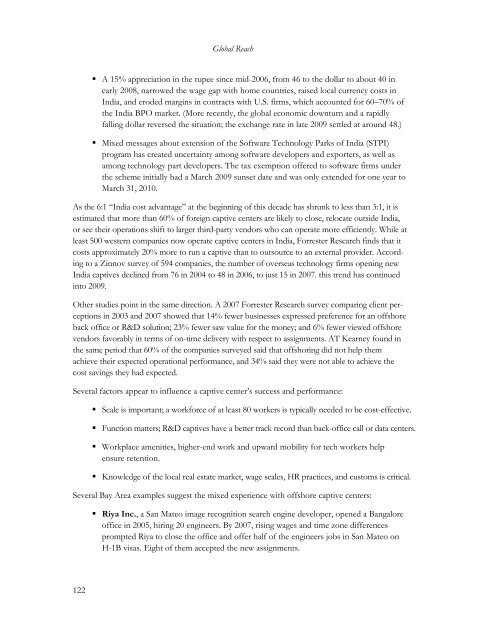PDF: 2962 pages, 5.2 MB - Bay Area Council Economic Institute
PDF: 2962 pages, 5.2 MB - Bay Area Council Economic Institute
PDF: 2962 pages, 5.2 MB - Bay Area Council Economic Institute
You also want an ePaper? Increase the reach of your titles
YUMPU automatically turns print PDFs into web optimized ePapers that Google loves.
Global Reach<br />
• A 15% appreciation in the rupee since mid-2006, from 46 to the dollar to about 40 in<br />
early 2008, narrowed the wage gap with home countries, raised local currency costs in<br />
India, and eroded margins in contracts with U.S. firms, which accounted for 60–70% of<br />
the India BPO market. (More recently, the global economic downturn and a rapidly<br />
falling dollar reversed the situation; the exchange rate in late 2009 settled at around 48.)<br />
• Mixed messages about extension of the Software Technology Parks of India (STPI)<br />
program has created uncertainty among software developers and exporters, as well as<br />
among technology part developers. The tax exemption offered to software firms under<br />
the scheme initially had a March 2009 sunset date and was only extended for one year to<br />
March 31, 2010.<br />
As the 6:1 “India cost advantage” at the beginning of this decade has shrunk to less than 3:1, it is<br />
estimated that more than 60% of foreign captive centers are likely to close, relocate outside India,<br />
or see their operations shift to larger third-party vendors who can operate more efficiently. While at<br />
least 500 western companies now operate captive centers in India, Forrester Research finds that it<br />
costs approximately 20% more to run a captive than to outsource to an external provider. According<br />
to a Zinnov survey of 594 companies, the number of overseas technology firms opening new<br />
India captives declined from 76 in 2004 to 48 in 2006, to just 15 in 2007. this trend has continued<br />
into 2009.<br />
Other studies point in the same direction. A 2007 Forrester Research survey comparing client perceptions<br />
in 2003 and 2007 showed that 14% fewer businesses expressed preference for an offshore<br />
back office or R&D solution; 23% fewer saw value for the money; and 6% fewer viewed offshore<br />
vendors favorably in terms of on-time delivery with respect to assignments. AT Kearney found in<br />
the same period that 60% of the companies surveyed said that offshoring did not help them<br />
achieve their expected operational performance, and 34% said they were not able to achieve the<br />
cost savings they had expected.<br />
Several factors appear to influence a captive center’s success and performance:<br />
• Scale is important; a workforce of at least 80 workers is typically needed to be cost-effective.<br />
• Function matters; R&D captives have a better track record than back-office call or data centers.<br />
• Workplace amenities, higher-end work and upward mobility for tech workers help<br />
ensure retention.<br />
• Knowledge of the local real estate market, wage scales, HR practices, and customs is critical.<br />
Several <strong>Bay</strong> <strong>Area</strong> examples suggest the mixed experience with offshore captive centers:<br />
• Riya Inc., a San Mateo image recognition search engine developer, opened a Bangalore<br />
office in 2005, hiring 20 engineers. By 2007, rising wages and time zone differences<br />
prompted Riya to close the office and offer half of the engineers jobs in San Mateo on<br />
H-1B visas. Eight of them accepted the new assignments.<br />
122








